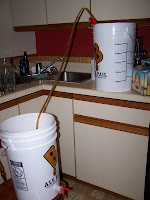 |
| Fermenter after 2 weeks |
It's been two weeks, the yeast has gone through their cycle in the fermenter. It's time to bottle. We're gonna use the bottling bucket, racking cane and tubing, bottling wand, bottle washer and at least 50 - 12 ounce bottles. You can use larger if you have them, but I like to recycle and reuse so I've saved and collected bottles that came with a pry-off cap. You can pick up a
bottle washer at any brew shop or online. It's around a $10 investment and it's well worth it. You can also get an adapter to attach it to a standard kitchen faucet. Bottles get pretty grimy after awhile and it really helps in the cleaning.
To carbonate the beer, we need to add priming sugar in the wort as we bottle. To do this, dissolve 5oz of priming sugar (aka corn sugar) in 1 cup of water and bring to a boil for 5 minutes. Remove from the heat and let cool. While we're waiting for this to cool, clean the bottles. Give them a good rinse with hot water through the bottle washer. If you need to, use a bottle brush to clean any residue stuck to the bottom of the bottles. For the really troublesome ones, I boil water in my electric kettle and pour it into the suspect bottle and let it sit to break up anything that we can't get out.
We will also need to clean the bottling bucket. If you haven't yet, it would be a good idea to sterilize first, using diluted bleach or other products. After it has been sterilized, fill the bucket with warm water and mix with a cleaning agent. I use Easy Clean, a no rinse cleanser made by LD Carlson. Hook up the hose with the bottling wand and clean everything by filling the bottles with the cleaning solution (if you are using caps, toss them in the bucket with the solution and then set them aside to dry after the bucket is empty).
This is a good chance to learn how to use the bottling set up and the wand. When the spigot is turned, the wand will fill and lock up. You'll notice that a little stopper is sticking out. When the wand is pressed into the bottle, the stopper will release. Fill the bottles til the solution reaches the lip and remove the wand. You'll notice the volume will drop to an appropriate level as you take it out. Let the solution sit in the bottles until ready to use.
 |
| Fermenter to bottling bucket |
Once the bucket is empty, dump any extra cleaning solution and set on a stool or chair. Don't worry about any small bits of solution left; as long as you followed the instructions of use, it will be safe for you and the beer. Place the fermenter on a counter or table that sets higher than the bottling bucket. The higher the original point of transfer, the smoother this will go. Make sure the spout on the bottling bucket is closed and pour in the cooled corn sugar. Use the racking cane and hose to transfer the beer from the fermenter to the bottling bucket. If you have a steady flow, this will mix the corn sugar during the transfer. If you need to, tip the fermenter to get the last of the fluid to transfer. Don't try to get every last drop because you want to keep as much sediment in the fermenter as possible. You'll find some gunk at the bottom, just set that aside to clean.
 |
| Bottles ready to be filled |
Place the bottling bucket where the fermenter was during the transfer. I like to keep the bottles on the floor during this process for easy clean up in case they are over filled (which will happen). Empty the bottles and line them up a row so that they will be within reach. Hook the hose and bottling wand back up to the bucket. Place the wand in the bottle to avoid any spilling and turn the spigot to start the flow. Fill the bottles just like we did with the cleaning solution, keeping that bit of head room at the top of the bottles. Once the bottles are filled, use the capper and seal all of the bottles. The yield should be around 48-50 bottles, give or take a few.
Keep the finished product in a cool place such as a closet or basement (as long as it's not winter). It would be a good idea to save 6 and 12 pack cases to help with organizing. Time for another week or two of waiting, the longer the better. You can push it and try a beer after a week, but if it seems under carbonated, give it an additional week.
 |
| Finished product! |




